Wildflowers of the Adirondack Park
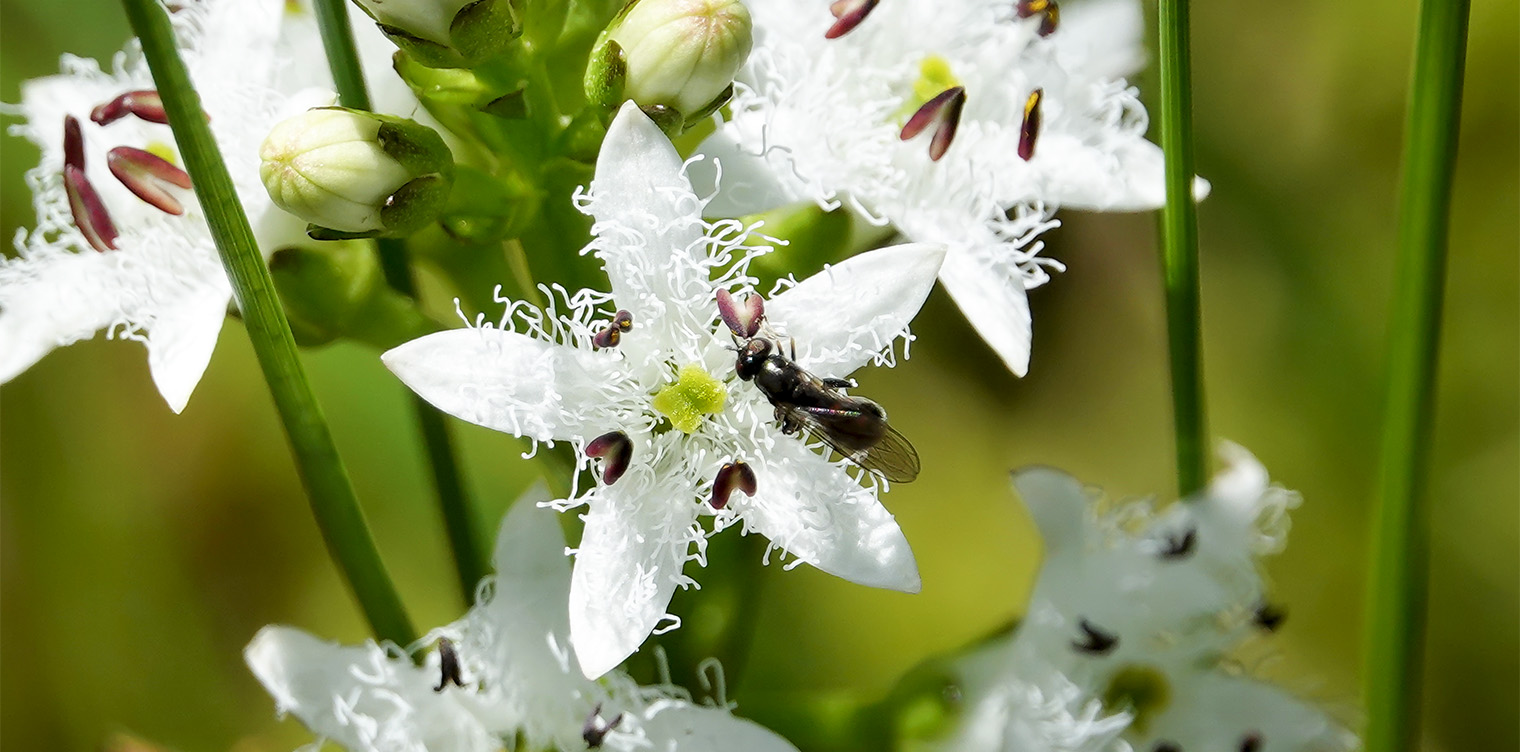
Wildflowers are a key component of Adirondack habitats. They sustain and are sustained by the plant life and wildlife around them. They are also a very accessible part of nature. Wildlife watchers may hike for days to catch a fleeting glimpse of a moose or Eastern Coyote. Bird watchers and photographers may need to make multiple trips to a habitat in hopes of catching a good view of an illusive species, only to see it fly away before the binoculars or camera can be raised.
Wildflowers, by contrast, do not fly away. They obligingly array themselves on the forest floor, awaiting inspection, identification, study, and photography. For that reason, learning about Adirondack wildflowers, and the roles they play in the different Adirondack habitats, is a very good place to begin to study the complex interrelationships that characterize the Adirondack forest. It seems that many people agree. The 2008 National Survey on Recreation and the Environment reported a participation rate of 118 million Americans in the category "View/Photograph Flowers." In terms of participation days, this was the fastest growing category of all 60 outdoor recreation activities measured between 1999 and 2008.
Wildflowers of the Northern Hardwood Forest in the Adirondacks
Wildflowers of the Northern Hardwood Forest
- Bunchberry (Cornus canadensis)
- Canada Mayflower (Maianthemum canadense)
- Carolina Springbeauty (Claytonia caroliniana)
- Clintonia (Clintonia borealis)
- Common Wood Sorrel (Oxalis montana)
- Dewdrop (Dalibarda repens)
- Dutchman’s Breeches (Dicentra cucullaria)
- Dwarf Ginseng (Panax trifolius)
- Foamflower (Tiarella cordifolia)
- Helleborine (Epipactis helleborine) *
- Indian Cucumber-root (Medeola virginiana)
- Indian Pipe (Monotropa uniflora)
- Jack in the Pulpit (Arisaema triphyllum)
- Painted Trillium (Trillium undulatum)
- Partridgeberry (Mitchella repens)
- Pink Lady's Slipper (Cypripedium acaule Aiton)
- Purple Trillium (Trillium erectum)
- Red Baneberry (Actaea rubra)
- Sessile Bellwort (Uvularia sessilifolia)
- Shinleaf (Pyrola elliptica)
- Squirrel Corn (Dicentra canadensis)
- Starflower (Trientalis borealis)
- Trout Lily (Erythronium americanum)
- White Baneberry (Actaea pachypoda)
- Wild Columbine (Aquilegia canadensis)
- Wild Sarsaparilla (Aralia nudicaulis)
- Wintergreen (Gaultheria procumbens)
*Nonnative
Wildflower watching in the Adirondacks (as in most other place) begins in spring. Wildflowers that make their home in hardwood forests must contend with a lot of shade. One way to deal with the limited sunlight reaching the forest floor is to get the business of growth, photosynthesis, reproduction, and food storage finished in the sunlight of early spring, before the canopy trees above leaf out and limit the sun reaching the forest floor
That's the strategy employed by spring ephemerals, the first wildflowers to bloom in deciduous forests in the Adirondack Mountains. These dainty plants, like Trout Lily, Carolina Springbeauty and Dutchman's Breeches, produce leaves, flowers, fruits, and seeds before going dormant and disappearing from view. These plants do more than just cheer up nature-lovers longing for a glimpse of spring. They also provide a food source for many insects at a time when little else is available. In turn, these insects pollinate the flowers and help spread the seeds.
Other spring-blooming wildflowers follow, including some very vigorous species, like the Bunchberry, a member of the Dogwood family that blooms for a relatively long time and sometimes carpets the forest floor with large colonies. Many of the wildflowers that bloom under deciduous trees in mid-spring are clothed in delicate white flowers. Two examples are Canada Mayflower and Foamflower, two small, relatively long-blooming plants with very similar delicate white flowers, but very different leaves. Another late-spring favorite is the Pink Lady's Slipper, a showy wildflower belonging to the orchid family.
By mid-summer, bloom activity in the Northern Hardwood Forest has slowed down. The Common Wood Sorrel, which produces delicate pink and white flowers on a backdrop of clover-like leaves, begins blooming in late spring, but often continues blooming through July. The Dewdrop, also called the False Violet, is another widespread Adirondack wildflower. The Dewdrop, which can be identified by its easily-recognized heart-shaped, scalloped leaves, produces small white flowers from early summer through mid-summer.
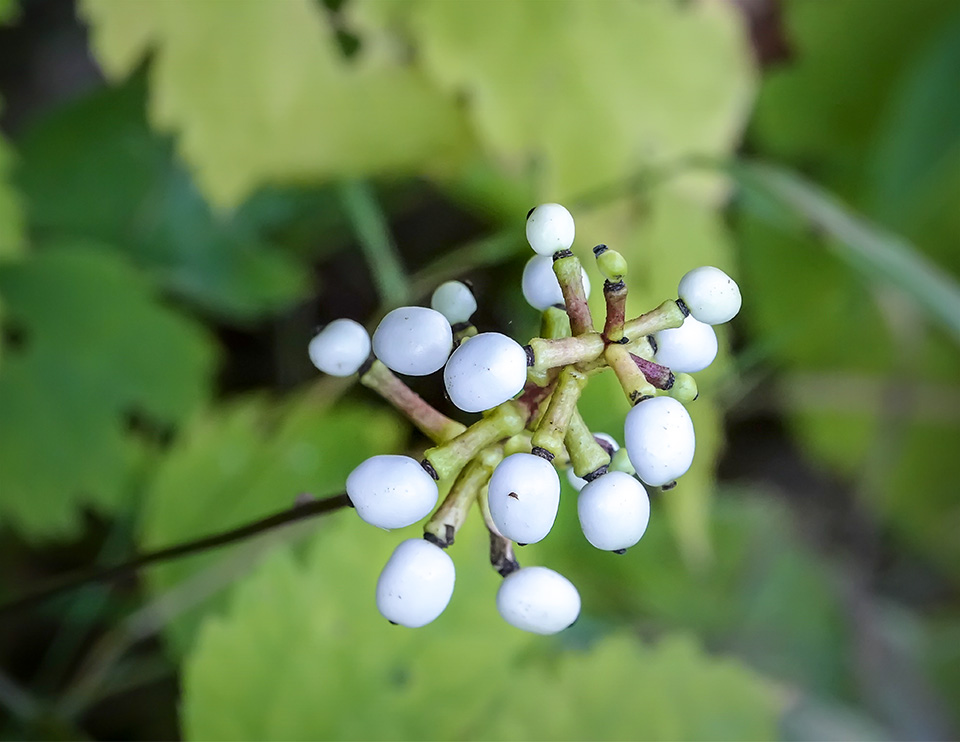
The main action in late summer and fall in the hardwood forest is provided by foliage and berries.
- The Jack in the Pulpit produces striking deep red berries in late summer.
- The Bunchberry overachieves by producing a cluster of bright red berries above attractive green foliage in late July. Its foliage later turns an eye-catching wine red, with splashes of dark purple, in late August and September.
- The two-tiered Indian Cucumber-root makes up for its underwhelming spring flowers by producing bluish-purple berries in early fall, against a backdrop of yellow foliage, with the smaller whorl of three leaves near the top splotched with a bright red center.
- Wild Sarsaparilla foliage turns orange, yellow, or deep red, with accented veins and margins.
- The foliage of White Baneberry turns an attractive yellowish green, with the veins and margins outlined in darker green. This plant also produce some striking white berries, studded with conspicuous dark purple spots. Meanwhile, Red Baneberry has decorated itself with equally eye-catching, bright red berries.
Wildflowers of the Adirondack Mixed Wood Forest
Wildflowers of Mixed Wood Forests
- Bunchberry (Cornus canadensis)
- Canada Mayflower (Maianthemum canadense)
- Clintonia (Clintonia borealis)
- Common Wood Sorrel (Oxalis montana)
- Cow-wheat (Melampyrum lineare)
- Dewdrop (Dalibarda repens)
- Dwarf Ginseng (Panax trifolius)
- Dwarf Rattlesnake Plantain (Goodyera repens)
- Fireweed (Chamerion angustifolium)
- Foamflower (Tiarella cordifolia)
- Goldthread (Coptis trifolia)
- Helleborine (Epipactis helleborine) *
- Indian Cucumber-root (Medeola virginiana)
- Indian Pipe (Monotropa uniflora)
- Jack in the Pulpit (Arisaema triphyllum)
- One-sided Wintergreen (Orthilia secunda)
- Painted Trillium (Trillium undulatum)
- Partridgeberry (Mitchella repens)
- Pink Lady's Slipper (Cypripedium acaule Aiton)
- Pipsissewa (Chimaphila umbellata)
- Red Baneberry (Actaea rubra)
- Rose Twisted Stalk (Streptopus lanceolatus)
- Roundleaf pyrola (Pyrola americana)
- Sessile Bellwort (Uvularia sessilifolia)
- Shinleaf (Pyrola elliptica)
- Spotted Touch-Me-Not (Impatiens capensis)
- Starflower (Trientalis borealis)
- Trout Lily (Erythronium americanum)
- Twinflower (Linnaea borealis)
- White Baneberry (Actaea pachypoda)
- Whorled Wood Aster (Oclemena acuminata)
- Wild Columbine (Aquilegia canadensis)
- Wild Sarsaparilla (Aralia nudicaulis)
- Wintergreen (Gaultheria procumbens)
* Nonnative
The spring cast of wildflowers in mixed wood forests is quite similar to that of the northern hardwood forest. A few species which seem to prefer a deciduous habitat and are generally absent outside of it (such as Squirrel Corn) drop out of the early spring array. However, added to the list of plants which grow in a mixed forest are other species which are less frequently found in hardwood forests in our region.
Most of the additions to the floral line-up for mixed deciduous/conifer forests are species which bloom through late summer.
- Spotted Touch-Me-Not is a mid-and late-summer wildflower which occurs in moist and wet areas in woods, swamps, beaver marshes and floodplains throughout the Adirondack Mountains and the north woods region. The orange flowers, which appear in July and August, hang on dangling stalks in clusters. The fruits are pale green pods which "explode" at the slightest touch, scattering the seeds. The name "Touch-me-not" is derived from this characteristic. The plant is also known as Jewelweed and Orange Jewelweed - a reference to the way the spotted blossoms hang like a pendent jewel. This species is an important source of food for the Ruby-throated Hummingbird, which reportedly contributes to its pollination. Bees and butterflies are also important pollinators.
- Another late-summer blooming plant abundant in mixed coniferous-deciduous forests is the Whorled Wood Aster. It is a native Adirondack wildflower that produces white flowers with pink or yellow centers in late summer. Whorled Wood Asters can bloom through September or early October in our region, depending on the weather. The leaves are large and are often scattered up the stem in such a way as to appear whorled. This plant is also known as the Sharp-leaved Aster – a reference to its coarsely-toothed leaf edges. This feature helps distinguish it from the Flat-topped White Aster, which has smooth leaves.
As in the hardwood forest, the forest floor of mixed conifer-deciduous areas is brightened in fall by those wildflowers that respond to the shortening days and decreasing temperatures with an interesting array of colorful foliage and berries. The colorful berries of the White and Red Baneberry, Bunchberry, Clintonia, Indian Cucumber-root, and Wintergreen add interest to the forest floor, as does the fall foliage of the baneberries, Wild Sarsaparilla, and Bunchberry.
Wildflowers of Adirondack Bogs
Wildflowers of Adirondack Bogs
- Buckbean (Menyanthes trifoliata)
- Cottongrass (Eriophorum)
- Creeping Snowberry (Gaultheria hispidula)
- Grass Pink (Calopogon tuberosus)
- Horned Bladderwort (Utricularia cornuta)
- Little Club-spur Orchid (Platanthera clavellata)
- Marsh Cinquefoil (Comarum palustre)
- Northern Pipewort (Eriocaulon aquaticum)
- Pitcher Plant (Sarracenia purpurea)
- Rose Pogonia (Pogonia ophioglossoides)
- Roundleaf Sundew (Drosera rotundifolia L.)
- Swamp Candles (Lysimachia terrestris)
- White Fringed Orchid (Platanthera blephariglottis)
Wildflowers which bloom in Adirondack bogs present a very different seasonal array. The earliest blooms on the bog appear later than in the surrounding upland, with bog-loving shrubs like Leatherleaf, Bog Laurel, Bog Rosemary, and Labrador Tea leading the way.
The wildflower action on the bog starts in late spring, but is well worth the wait. The starry white flowers of Buckbean usually make an appearance in late May, as does the early-blooming variety of Cottongrass and the tiny Creeping Snowberry, which can be found on the margins of bogs.
Also blooming in late spring is one of the bog's most eye-catching residents: the carnivorous Pitcher Plant. The tubular leaves of this plant can be seen nestling in bog vegetation in other seasons. Its large, nodding, deep-red flowers appear in late spring and can be seen through midsummer. Like other insectivorous plants which flourish in the nutrient poor environment of bogs, the Pitcher Plant carries on photosynthesis like other green plants, but supplements its nutrition by capturing and digesting small insects. It has tubular leaves surrounding the base of the plant. Insects enter the mouth of the plant and are trapped by the hairs. They then drown in the leaf fluid and are digested by enzymes and bacteria. The nutrients absorbed from the insects supplement the nutrients absorbed by the roots.
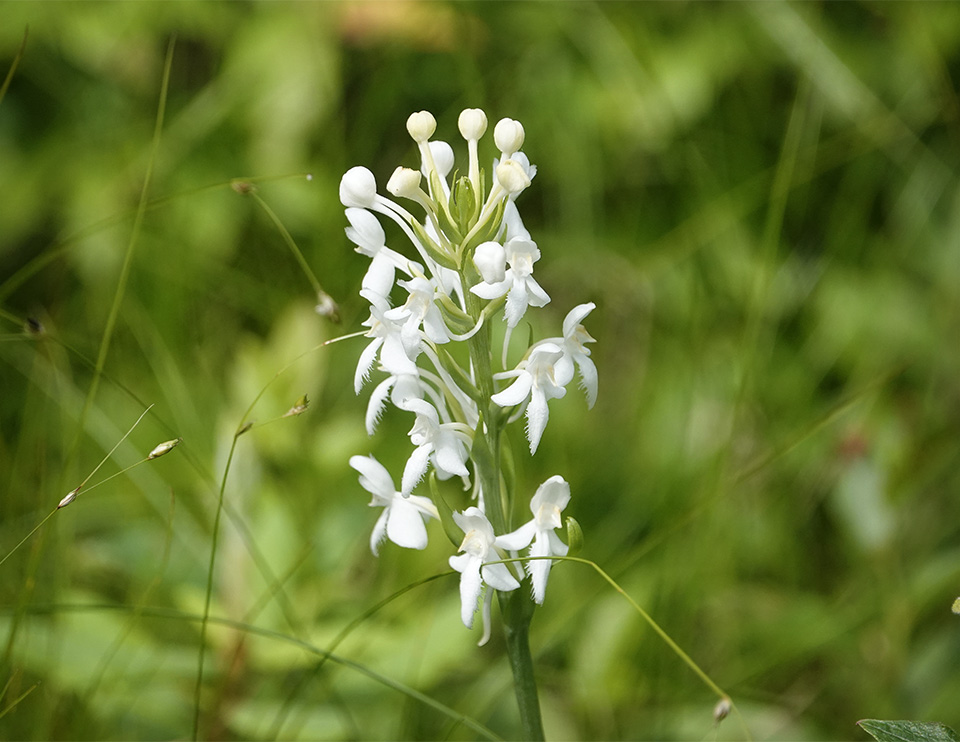
Early summer is the start of orchid season on Adirondack bogs. Orchids that thrive in the wet soil of the bog include Grass Pink. This delicate, sweet-smelling orchid often springs from peat or sphagnum moss and is easily recognized by the bearded lip petal and long, narrow,, grass-like leaves (from which it gets its name). The rose-pink or pale orchid blossoms are sweet-smelling and generally bloom in late June or early July in our region.
Another bog-dwelling orchid which blooms in early summer is Rose Pogonia. It produces pink flowers and blooms beginning in late June. The Latin name "Pogonia" means beard – a reference to the bearded lip on the flower. This bog-dwelling orchid sports a single rose-pink flower from late June through mid-July. The petals of the flower have a delicate fragrance when fresh, said to be reminiscent of red raspberries or sweet violets. The lower lip petal is deeply fringed and bearded in the center with yellow bristles.
Another orchid that begins blooming in early summer is the White Fringed Orchid. Its small white flowers (twenty or more) each have a deeply fringed lip petal and form a compact cluster at the top of the stem. The flowers of the Little Club-spur Orchid appear a little later, usually in late July or early August. Its greenish-white or yellowish-white flowers are ¼ inches wide, and twisted along the stalk. The spur is very long, slender, and curved.
Wildflowers of the Adirondack Marsh
Wildflowers of Adirondack Marshes
- Blue Flag (Iris versicolor)
- Bunchberry (Cornus canadensis)
- Cardinal Flower (Lobelia cardinalis)
- Cottongrass (Eriophorum)
- Creeping Snowberry (Gaultheria hispidula)
- Fireweed (Chamerion angustifolium)
- Northern Pipewort (Eriocaulon aquaticum)
- Pickerelweed (Pontederia cordata)
- Spotted Joe Pye Weed (Eutrochium maculatum)
- Spotted Touch-Me-Not (Impatiens capensis)
- Swamp Candles (Lysimachia terrestris)
- Tall Meadow Rue (Thalictrum pubescens)
- White Turtlehead (Chelone glabra)
- White Water-lily (Nymphaea odorata ssp. odorata)
- Yellow Pond Lily (Nuphar variegata)
Wildflower activity on Adirondack marshes also gets going in earnest in early summer. Wetland plants which flourish in this type of wetland include floating plants, emergents, and other wildflowers that don't mind getting their feet wet and flourish on marsh edges.
The two main floating plants which dominate the Adirondack marsh are Yellow Pond Lily and White Water-lily. Both are anchored to the bottom by roots and have long stalks to leaves that float on the surface of the water. The water lilies provide food and shelter for many fish and underwater insects and are favorite habits for green and mink frogs.
- Yellow Pond Lily starts blooming in June; its deep yellow flowers are about two inches wide and grow above the water. The flowers, which are pollinated by flies and beetles, are two to six inches wide and are usually open in the morning, closing by mid-afternoon on sunny days. Each flower has many upright or spreading petals surrounding a yellow center.
- White Water-lily blooms from late June to mid-August. The plant is pollinated by beetles, which have a more highly developed sense of smell than sense of sight. The round leaves of the plant, which are cleft at the base, are green on top and purple on the underside and float on the surface.
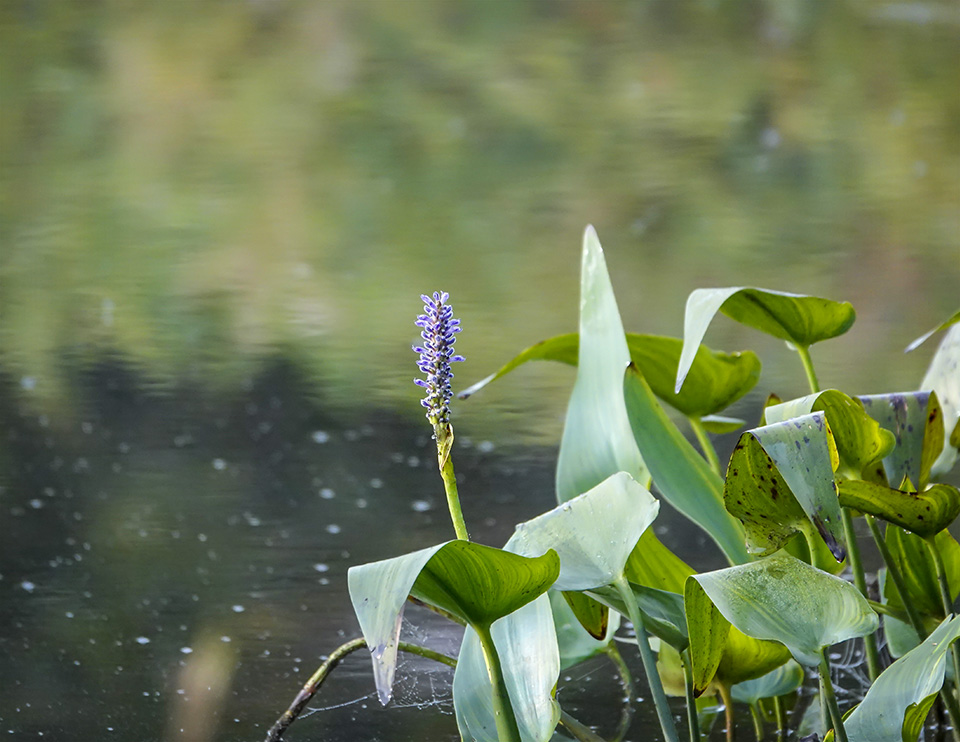
At lower water depths, emergents (such as Pickerelweed and Broad-leaved Cattail) flourish. Bladderworts also thrive here; these are submersed free-floating plants featuring tiny bladders attached to the leaves, which trap and digest very tiny animals. Pickerelweed grows in marshes, swamps, lake shores, wet meadows, and the shallow waters of marsh and pond edges. It produces showy purple-blue flowers in July and August. The flowers are arranged in a spike up to six inches long and bloom in succession from the bottom up. The flowers are pollinated by bees. The plant is one to four feet tall, with heart-shaped green leaves.
Plants which flourish on the edges of Adirondack marshes include Blue Flag, which blooms in early summer and grows in profusion in the shallow water of the margins of many Adirondack marshes. It can also grow in moist soils on the shorelines of lakes and ponds. Its down-curved violet sepals are veined in yellow and white. The flowers are 2.5 to 4 inches wide. The plant is 2-3 feet tall with long, narrow leaves (1/2 to 1 inch wide) of bluish green. Blue Flag plants are pollinated by bees and, like other plant species pollinated by bees, have evolved special types of flowers that are easy for bees to find. Blue Flag has large lobes that bees use as landing platforms and special markings directing bees to the nectar glands.
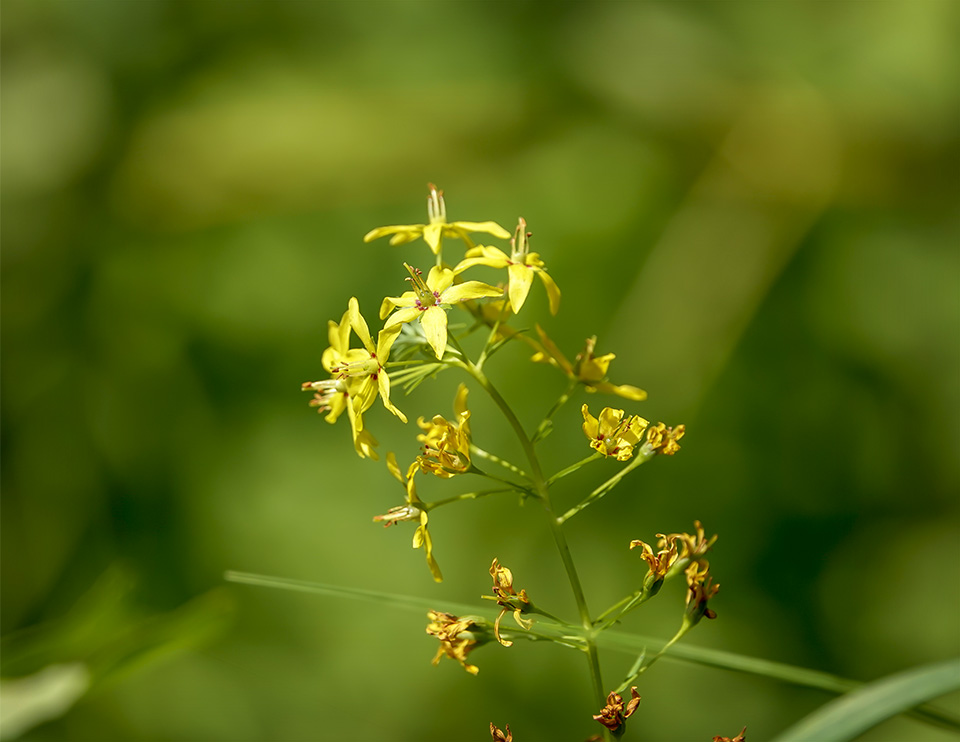
The drier edges of the marsh are home to Swamp Candles – an erect, perennial plant growing one to three feet tall. The leaves are lance-shaped and stalkless, up to four inches long, and usually opposite. The stems are smooth and green, sometimes with maroon streaks. This plant blooms in mid-summer, displaying an attractive cluster of small yellow flowers. Each flower is about 5/8 inches wide, with five narrow yellow petals. Each petal is marked with two red spots on the base. Swamp Candles' fruit is a dark, dotted capsule. Swamp Candles can be found in the eastern half of the US and Canada, including most counties in the Adirondack Park. Swamp Candle plants prefer poorly-drained soil in mostly sunny or partly sunny sites. This plant may be seen growing in a wide variety of wetland habitats, including swamps, marshes, bogs, fens, stream banks, pond and lake margins, wet ditches, and wet meadows.
Another plant to look for at the edges of marshland is Spotted Joe Pye Weed – a member of the Aster family which is common in wet open sites, including swamps, marshes, and set pastures. It grows up to six feet tall, with purple or purple-spotted stems, with the coarsely-toothed leaves arranged in whorls. Spotted Joe Pye Weed produces flat, branched clusters of attractive dusty pink to pale purple flowers, starting in midsummer. Pollinating insects such as bees, flies, and butterflies are attracted by the nectar deep in the tubular florets, making patches of Joe Pye Weed a convenient place to catch a glimpse of butterflies like swallowtails and fritillaries.
Wildflowers of Adirondack Swampland
Wildflowers of Adirondack Swamps
- Blue Flag (Iris versicolor)
- Bunchberry (Cornus canadensis)
- Canada Mayflower (Maianthemum canadense)
- Cardinal Flower (Lobelia cardinalis)
- Clintonia (Clintonia borealis)
- Common Wood Sorrel (Oxalis montana)
- Cottongrass (Eriophorum)
- Creeping Snowberry (Gaultheria hispidula)
- Dewdrop (Dalibarda repens)
- Flat-topped White Aster ( Doellingeria umbellata)
- Foamflower (Tiarella cordifolia)
- Goldthread (Coptis trifolia)
- Marsh Cinquefoil (Comarum palustre)
- Partridgeberry (Mitchella repens)
- Pickerelweed (Pontederia cordata)
- Pitcher Plant (Sarracenia purpurea)
- Rose Pogonia (Pogonia ophioglossoides)
- Spotted Joe Pye Weed (Eutrochium maculatum)
- Spotted Touch-Me-Not (Impatiens capensis)
- Tall Meadow Rue (Thalictrum pubescens)
- White Fringed Orchid (Platanthera blephariglottis)
- Trailing Arbutus (Epigaea repens)
- Twinflower (Linnaea borealis)
- Starflower (Trientalis borealis)
- Swamp Candles (Lysimachia terrestris)
- Swamp Milkweed (Asclepias incarnata)
- Wild Sarsaparilla (Aralia nudicaulis)
- White Turtlehead (Chelone glabra)
Wildflowers that flourish in swampland are those able to survive in soil that is often waterlogged. The list is a lengthy one, because it includes plants able to grow in several other habitats, as well as plants that require wet soil. You can often find swamp-dwelling wildflowers highlighted against a rich tapestry of ferns and mosses.
The first of the swampland wildflowers to bloom in early spring is the Trailing Arbutus; its fragrant white or pink blooms generally appear before the deciduous trees leaf out in late April or early May, depending on the weather.
Mid-spring brings Creeping Snowberry, Goldthread, and Starflower.
- Creeping Snowberry (which is classified as a subshrub) is a low trailing perennial plant found in bogs, marshes, and swamps in the Adirondacks. The pale green-white flowers are seen in spring (April-May), followed by the white berries in late summer. It sometimes forms a dense mat, creating a miniature landscape.
- Goldthread is an Adirondack woodland perennial, 3-6 inches tall, which produces a solitary white flower on a long, slender, leafless stem. The common name refers to the yellow, thread-like underground roots.
- Starflower is a woodland perennial, which produces one or two star-shaped white flowers above a whorl of 5-10 unequal, narrow thin leaves at the top of the stem. Starflower can be found in a wide range of habitats, including mixed forests, mossy bogs, and conifer swamps.
In late spring and early summer, look for Bunchberry, Canada Mayflower, Clintonia, Wild Sarsaparilla, and Common Wood Sorrel – familiar and widespread wildflowers which have a rather broad tolerance in terms of plant communities and can be found in several other Adirondack habitats as well.
- Bunchberry's vibrant green leaves and bright white dogwood-type flower is particularly stunning in shady swamps against a textured backdrop of Common Haircap Moss.
- Canada Mayflower, another very abundant Adirondack native, has shiny dark green leaves with heart-shaped or broadly rounded bases that tend to clasp the stem. These plants bloom in May, producing a cluster of tiny white flowers held in upright clusters on separate, delicate stems.
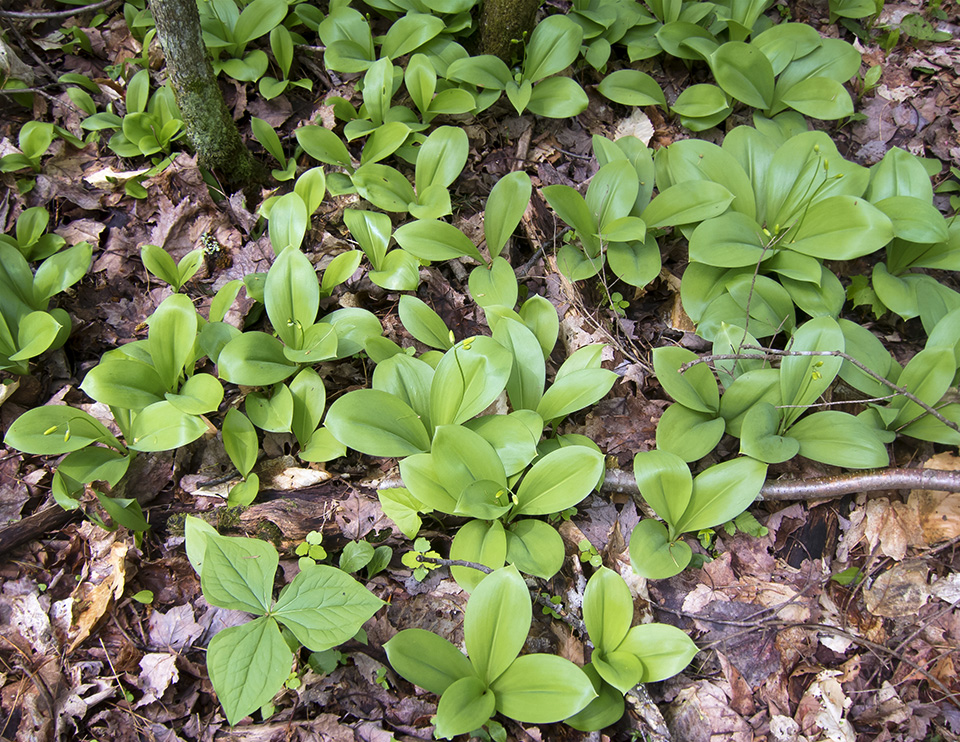
Also adding to the color on the forest floor starting in late spring is Clintonia, a perennial member of the lily family which produces 3-6 pale yellow, drooping, bell-like flowers from late May through June. It is often called Blue Bead Lily – a reference to the porcelain blue berries produced in mid- to late summer.
Another late spring bloomer is Wild Sarsaparilla. It produces tiny greenish white flowers, usually in three globe-shaped clusters 1.6 to 2.0 inches wide, starting in late May in the Adirondacks. Its common name refers to its traditional use in making root beer.
Other late spring bloomers include Common Wood Sorrel and Twinflower. The latter is a miniature evergreen creeping plant that produces pairs of fragrant pink, bell-like flowers in late spring or early summer. Its trailing stems reach three feet in length.
Mid- and late-summer in Adirondack swamps brings Dewdrop, Swamp Candles, White Turtlehead, and Swamp Milkweed.
- Dewdrops can flourish in a wide variety of habitats, including moist hardwood and coniferous forests, but some of the other summer swampland bloomers, such as Swamp Candles, are more specialized to wet soils.
- Another example of a mid- to late summer bloomer is White Turtlehead. It grows up to four feet tall; its blooms are tight terminal clusters of white (often lavender-tinged) tubular, 2-lipped flowers resembling turtle heads. Look for White Turtlehead in brushy marshes, wet ditches, low meadows, and the swampy areas near the banks of streams.
- Swamp Milkweed also prefers wet soils and is typically found growing near the edges of ponds, lakes, streams, and low areas. Swamp Milkweed is an important plant in the life cycle of the Monarch Butterfly, which feeds on the flowers and lays its eggs on the plant.
Wildflowers of Adirondack Old Fields
Adirondack Old Field Wildflowers
- Bee-balm (Monarda didyma)
- Butter-and-eggs (Linaria vulgaris)*
- Canada Goldenrod (Solidago canadensis)
- Chicory (Cichorium intybus) *
- Coltsfoot (Tussilago farfara) *
- Common Bluets (Houstonia caerulea)
- Common Chickweed (Cerastium arvense) *
- Common Dandelion (Taraxacum officinale) *
- Common Evening-primrose (Oenothera biennis)
- Common Milkweed (Asclepias syriaca)
- Common Selfheal (Prunella vulgaris)
- Common Yarrow (Achillea millefolium)
- Eastern Daisy Fleabane (Erigeron annuus)
- Fireweed (Chamerion angustifolium)
- Flat-top Goldentop (Euthamia graminifolia)
- Fringed Black Bindweed (Polygonum cilinode)
- Hop clover (Trifolium aureum) *
- Narrowleaf Blue-eyed Grass (Sisyrinchium angustifolium)
- New England Aster (Sympyotrichum novae-angliae)
- Orange Hawkweed (Pilosella aurantiaca) *
- Parasol Whitetop (Doellingeria umbellata)
- Pearly Everlasting (Anaphalis margaritacea)
- Philadelphia Fleabane (Erigeron philadelphicus)
- Queen Anne's Lace (Daucus carota) *
- St. John's Wort (Hypericum perforatum) *
- Spotted Knapweed (Centaurea stoebe) *
- Spreading Dogbane (Apocynum androsaemifolium)
- Wrinkleleaf Goldenrod (Solidago rugosa)
* Nonnative
Many of the wildflowers that bloom in summer and fall are found in Adirondack old fields. These include abandoned farmland not yet taken over by successional forests and other fields that are mowed less than once per year. Wildflowers that flourish in these ecological communities depend on the type of soil, drainage, and the length of time the area has been left on its own, among other factors. Many old field wildflowers can also be found on roadsides and under power lines.
Some of the summer and fall-blooming plants commonly found in Adirondack old fields are native wildflowers.
- Spreading Dogbane sports clusters of fragrant, bell-shaped pink flowers in late June and July. The inside of the flower has deep rose markings. The flowers are said to attract butterflies and bees. The stems and leaves of the Spreading Dogbane plant, when broken, exude a milky sap. Spreading Dogbane grows in open to lightly shaded sites in old fields and along the edges of woods. It is common throughout northern New York and the northern portions of North America.
- Common Evening-primrose is another native plant that colonizes old fields. Its name comes from the fact that its bright yellow flowers remain partially to fully closed during the day and open in the evening. The fragrant flowers usually last only one to two days. This plant can be seen blooming summer in dry open fields, along roadsides, railroad embankments, waste areas and in open woods.
- Adirondack old fields are also home to a variety of native summer-blooming asters, plants which produce many tiny tubular flowers on a flowering disk surrounded by a row of colorful rays. The New England Aster grows up to three or four feet tall and produces purple daisy-like flowers with yellow disk florets in late summer and fall. This plant thrives in damp grasslands and old fields. New England Asters have hairy stems, distinguishing them from New York Asters, which thrive in similar habitats and have smooth stems.
- A variety of native goldenrods can also be found blooming in old fields. Flat-top Goldentop is an upright, erect, native perennial, growing up to four feet in height and producing bright yellow flowers. It can be found in moist meadows, clearings, and roadsides.
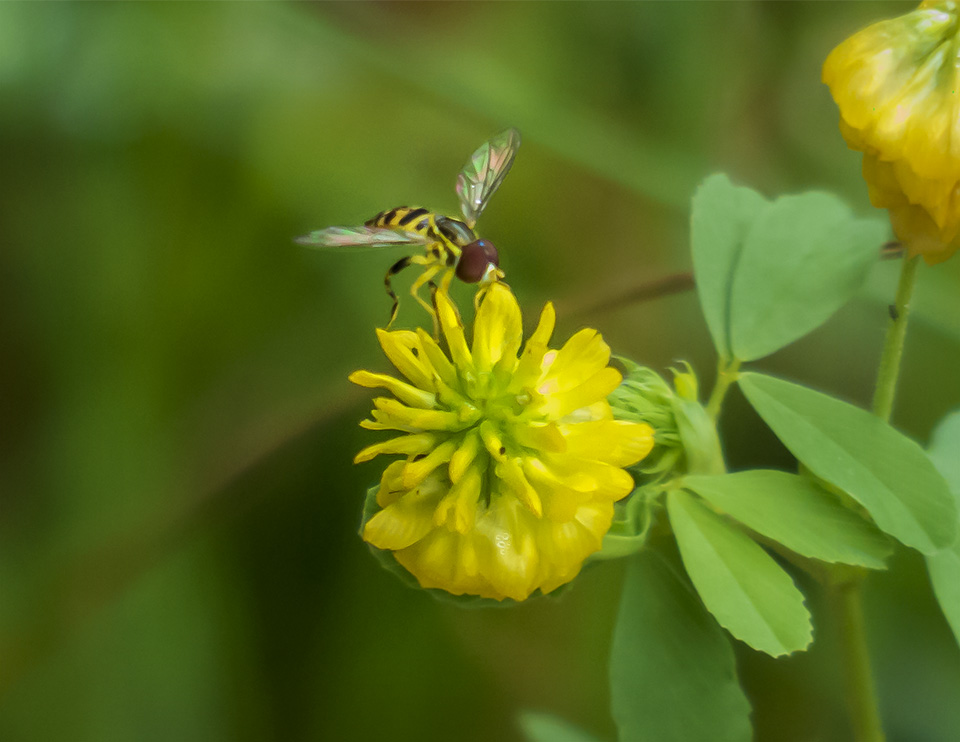
Other plants commonly found blooming in old fields are nonnatives. Some are considered invasive in some areas.
Hop clover is a non-native plant which produces bright yellow flower clusters in the summer. The flowers are arranged into small, elongated round head-like cluster. The clusters are 1/4 to 1/2 inch across. As they age, the flowers become brown and paper-like. Like all clovers, this plant has leaves divided into three leaflets. It grows in part shade and sun along roadsides and trails and in disturbed areas, successional fields, and waste places in many locations in the Adirondack Mountains and upstate New York. This plant usually blooms from late June through early September, depending on the weather.
Orange Hawkweed, also called Devil's Paintbrush, is a nonnative plant that is considered invasive in some areas, because it forms extensive mats that can compete with forest understory plants. It invades different habitats including moist meadows, pasture, hay fields, open woods, and roadsides. It produces bright orange flowers from early June through October.
St. John's Wort is an introduced species that is considered invasive. It invades disturbed areas, forming dense colonies that crowd out native plants. St Johnswort is commonly found in grasslands, pastures, meadows, and old fields, but can also be found in forested areas that have been disturbed by fire, logging, or road construction. St John's Wort produces golden yellow flowers from June through September.
Wildflowers of Early Successional Forests in the Adirondacks
Wildflowers of Adirondack Early Successional Forests
- Bee-balm (Monarda didyma)
- Bunchberry (Cornus canadensis)
- Canada Goldenrod (Solidago canadensis)
- Coltsfoot (Tussilago farfara)*
- Eastern Daisy Fleabane (Erigeron annuus)
- Fireweed (Chamerion angustifolium)
- Flat-top Goldentop (Euthamia graminifolia)
- Fringed Black Bindweed (Polygonum cilinode)
- Hop clover (Trifolium aureum) *
- Queen Anne's Lace (Daucus carota) *
- Spotted Knapweed (Centaurea stoebe) *
- Spotted Touch-Me-Not (Impatiens capensis)
- St. John's Wort (Hypericum perforatum) *
- Spreading Dogbane (Apocynum androsaemifolium)
- Wrinkleleaf Goldenrod (Solidago rugosa)
* Nonnative
Many of the wildflowers which bloom in summer and early fall in the Adirondacks are found in early successional forests. The array of wildflowers seen in this ecological community depends on how long ago the disturbance took place, the nature of the disturbance (agriculture, logging, fire, or weather events), and what the area looked like before the disturbance. Early successional forests, as defined here, are forests younger than 20 years.
Native wildflowers found in early successional forests include some of the same sun-loving plants characteristic of old fields.
- Native plants which grow in this habitat include Fireweed, a member of the Evening Primrose family that produces pinkish purple flowers in a slender, pyramid-shaped terminal cluster in mid- and late-summer. So-named because it often is one of the first plants to recolonize a fire-barren landscape, Fireweed can also be found on roadsides, fields, and low, damp ground on river banks and lake shores. It attracts a variety of insects, including Red Admiral Butterflies, swallowtails, and hairstreaks.
- Fringed Black Bindweed, another native plant, is also commonly found in forests recovering after logging operations. It is a fast-growing perennial vine with red stems and distinctive widely spaced, heart-shaped leaves. This plant produces a terminal, spike-like cluster of small white flowers. It blooms from late spring through summer. It is also common in recently-burned areas and thickets.
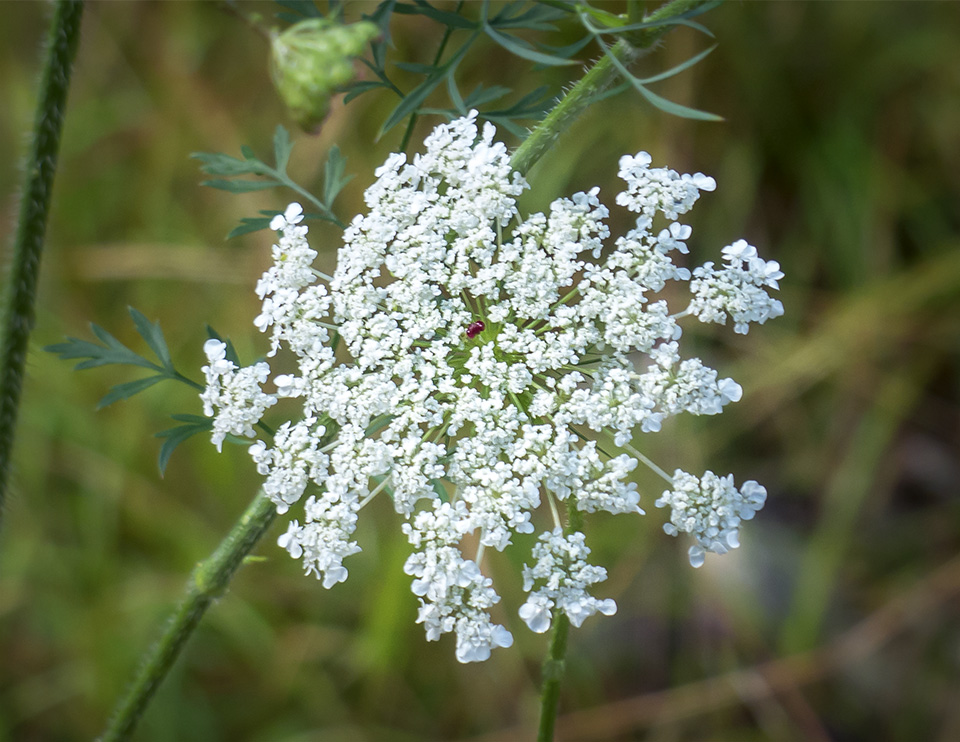
Early successional forests are also home to a variety of nonnative wildflowers, most of which bloom in summer and early fall.
- Queen Ann's Lace is is a nonnative biennial that is also known as wild carrot. This plant, which is classified as a noxious weed in several states, produces a lacy flower cluster made up of numerous tiny white flowers. Queen Anne’s Lace blooms from mid-summer to early fall. It is found in early successional forests and other disturbed habitats, as well as fields, meadows, waste areas, and roadsides. This plant is very hardy and can thrive in a dry environment.
- Another nonnative that has invaded a wide variety of habitats is Spotted Knapweed. A sun lover, Spotted Knapweed thrives in disturbed areas and old fields and can commonly be found in the wake of logging operations in Adirondack forests. It was accidentally introduced into North America in the late 1800s and is now widely distributed in the US. Like St John's Wort, it is on the list of invasive plants maintained by the National Invasive Species Information Center (NISIC). Its bluish lilac blooms, which are actually quite attractive, are seen throughout the summer months.
References
H. Ken Cordell, "The Latest on Trends in Nature-based Outdoor Recreation," Forest History Today. Spring 2008. pp. 4-10. Retrieved 15 November 2022.
Outdoor Recreation Activity Trends: What’s Growing, What’s Slowing? A Recreation Research Report in the IRIS Series 1. September 2008. Retrieved 15 November 2022.
H. Ken Cordell. Outdoor Recreation Trends and Futures: A Technical Document Supporting the Forest Service 2010 RPA Assessment. March 2012. Retrieved 15 November 2022.
J.M. Bowker et al. Outdoor Recreation Participation in the United States–Projections to 2060: A Technical Document Supporting the Forest Service 2010 RPA Assessment. July 2012. Retrieved 15 November 2022.
Miranda H. Mockrin, Richard A. Aiken and Curtis H. Flather. Wildlife-associated Recreation Trends in the United States: A Technical Document Supporting the Forest Service 2010 RPA Assessment. 2012. Retrieved 15 November 2022.
H. Cordell, Carter Betz, and Gary Green, “Nature-Based Outdoor Recreation Trends and Wilderness,” International Journal of Wilderness, Volume 14 (January 2008). Retrieved 15 November 2022.
Eric White, et al. Federal Outdoor Recreation Trends: Effects On Economic Opportunities. Gen. Tech. Rep. PNW-GTR-945. Portland, OR: U.S. Department of Agriculture, Forest Service, Pacific Northwest Station. 2016. Retrieved 15 November 2022.
Michael Kudish. Adirondack Upland Flora: An Ecological Perspective (Saranac, New York: The Chauncy Press, 1992).
John Kricher. A Field Guide to Eastern Forests. North America (Boston: Houghton Mifflin, 1998), pp. 154-219.
Peter J. Marchand. Nature Guide to the Northern Forest. Exploring the Ecology of the Forests of New York, New Hampshire, Vermont, and Maine (Appalachian Mountain Club, 2010), pp. 13-18, 56-93.
William K. Chapman and Alan E. Bessette. Trees and Shrubs of the Adirondacks: A Field Guide (Utica, New York: North Country Books, 1990).
Donald J. Leopold and Lytton John Musselman. Wildflowers of the Adirondacks (Johns Hopkins University Press, 2020).
Anne McGrath. Wildflowers of the Adirondacks (EarthWords, 1981, 2000).
Doug Ladd. North Woods Wildflowers (Falcon Publishing, 2001).
Lawrence Newcomb. Newcomb's Wildflower Guide (Little Brown and Company, 1977).
Roger Tory Peterson and Margaret McKenny. A Field Guide to Wildflowers. Northeastern and North-central North America (Houghton Mifflin Company, 1968).
National Audubon Society. Field Guide to Wildflowers. Eastern Region. (Alfred A. Knopf, 2001).
William K. Chapman, et al. Wildflowers of New York in Color (Syracuse University Press, 1998).
Ruth Schottman, Trailside Notes: A Naturalist's Companion to Adirondack Plants (Adirondack Mountain Club, 1998).
William K. Chapman. Orchids of the Northeast. A Field Guide (Syracuse University Press, 1997). Retrieved 15 November 2022.
Donald D. Cox. A Naturalist's Guide to Wetland Plants. An Ecology for Eastern North America (Syracuse University Press, 2002).
Meiyin Wu and Dennis Kalma. Wetland Plants of the Adirondacks. Herbaceous Plants and Aquatic Plants (Trafford Publishing, 2010).
John Eastman. The Book of Swamp and Bog: Trees, Shrubs, and Wildflowers of Eastern Freshwater Wetlands (Stackpole Books, 1995).
John Eastman. The Book of Forest and Thicket: Trees, Shrubs, and Wildflowers of Eastern North America (Stackpole Books, 1992).
John Eastman. The Book of Field and Roadside: Open-Country Weeds, Trees, and Wildflowers of Eastern North America (Stackpole Books, 2003).
Gary Wade et al. Vascular Plant Species of the Forest Ecology Research and Demonstration Area, Paul Smiths, New York. USDA Forest Service. Research Note NE-380. Retrieved 22 January 2017.
Mark J. Twery, at al. Changes in Abundance of Vascular Plants under Varying Silvicultural Systems at the Forest Ecosystem Research and Demonstration Area, Paul Smiths, New York. USDA Forest Service. Research Note NRS-169. Retrieved 22 January 2017.
Katherine Yard and Elizabeth Cooper. Young Forest Initiative Monitoring Plan. 2016 - 2025 (NYS Department of Environmental Conservation, 22 April 2016), Appendix A. Young Forest Wildlife. pp. 20-27.
Jeffrey S. Ward. Northeastern Forest Regeneration Handbook: A Guide for Forest Owners, Harvesting Practitioners, and Public Officials. USDA Forest Service. NA–TP–03–06 July 2006. Retrieved 18 January 2017.
New York State. Adirondack Park Agency. Natural Communities of the Adirondack Park. Retrieved 13 January 2017.
New York State Department of Environmental Conservation. New York Natural Heritage Program. Ecological Communities of New York State. Second Edition (March 2014). Retrieved 17 January 2017.
New York Natural Heritage Program. 2022. Online Conservation Guide for Beech-Maple Mesic Forest. Retrieved 15 November 2022.
New York Natural Heritage Program. 2022. Online Conservation Guide for Black Spruce-Tamarack Bog. Retrieved 15 November 2022.
New York Natural Heritage Program. 2022. Online Conservation Guide for Boreal Heath Barrens. Retrieved 15 November 2022.
New York Natural Heritage Program. 2022. Online Conservation Guide for Deep Emergent Marsh. Retrieved 15 November 2022.
New York Natural Heritage Program. 2022. Online Conservation Guide for Dwarf Shrub Bog. Retrieved 15 November 2022.
New York Natural Heritage Program. 2022. Online Conservation Guide for Hemlock-Hardwood Swamp. Retrieved 15 November 2022.
New York Natural Heritage Program. 2022. Online Conservation Guide for Hemlock-Northern Hardwood Forest. Retrieved 15 November 2022.
New York Natural Heritage Program. 2022. Online Conservation Guide for Inland Poor Fen. Retrieved 15 November 2022.
New York Natural Heritage Program. 2022. Online Conservation Guide for Northern White Cedar Swamp. Retrieved 15 November 2022.
New York Natural Heritage Program. 2022. Online Conservation Guide for Patterned Peatland. Retrieved 15 November 2022.
New York Natural Heritage Program. 2022. Online Conservation Guide for Pine-Northern Hardwood Forest. Retrieved 15 November 2022.
New York Natural Heritage Program. 2022. Online Conservation Guide for Rich Hemlock-Hardwood Peat Swamp. Retrieved 15 November 2022.
New York Natural Heritage Program. 2022. Online Conservation Guide for Shallow Emergent Marsh. Retrieved 15 November 2022.
New York Natural Heritage Program. 2022. Online Conservation Guide for Shrub Swamp. Retrieved 15 November 2022.
New York Natural Heritage Program. 2022. Online Conservation Guide for Spruce-Fir Swamp. Retrieved 15 November 2022.
New York State. Department of Environmental Conservation. Strategic Plan for State Forest Management. 2011. Chapter 2, pp. 46-52. Retrieved 15 November 2022.
New York State Forest Resource Assessment and Strategy: 2010 – 2015 Keeping New York’s Forests as Forests (New York State. Department of Environmental Conservation, 2010), pp. 24-30.
